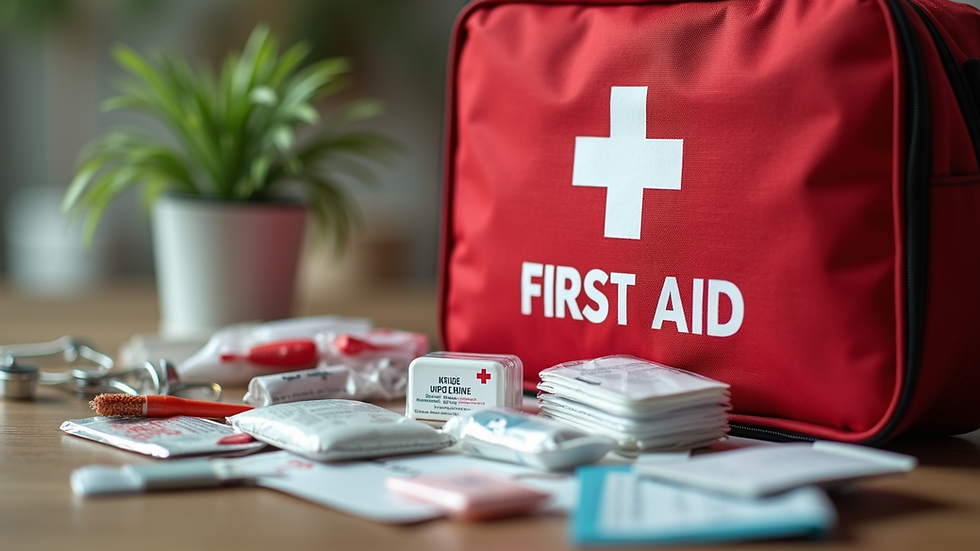Why First Aid for Children Requires Specialized Training
- Aryeh Goldberg

- Jul 28
- 4 min read
When it comes to emergencies involving children, the stakes are incredibly high. Children are not just small adults; their bodies and responses to injuries or illnesses differ significantly. This is why child first aid requires specialized training. Understanding these differences can make a critical impact on the outcome of an emergency situation. This article explores why specialized training is essential, what sets child first aid apart, and how you can be better prepared to help children in need.
Understanding the Importance of Child First Aid
Child first aid is a vital skill that can save lives. Children are more vulnerable to accidents and medical emergencies due to their developing bodies and natural curiosity. Unlike adults, children have different physiological and psychological needs that require tailored first aid responses.
For example, a child's airway is smaller and more easily blocked, making choking a common and dangerous risk. Their bones are more flexible but also more prone to certain types of fractures. Additionally, children may not be able to communicate their symptoms clearly, which makes assessment more challenging.
Specialized child first aid training equips caregivers, teachers, and parents with the knowledge to:
Recognize signs of distress specific to children
Perform age-appropriate CPR and rescue techniques
Manage common childhood injuries such as burns, fractures, and allergic reactions
Provide reassurance and comfort to a frightened child during an emergency
By learning these skills, you can respond quickly and effectively, increasing the chances of a positive outcome.

Child first aid kits contain specific items tailored for treating children’s injuries.
Key Components of Child First Aid Training
Child first aid training covers a range of topics that differ from general first aid. The training is designed to address the unique needs of infants, toddlers, and older children. Here are some key components:
Airway Management and CPR for Children
Children’s airways are smaller and more delicate. The techniques for clearing an airway obstruction or performing CPR differ in depth and force compared to adults. Training teaches how to adjust these techniques safely.
Recognizing Childhood Illnesses and Injuries
Symptoms of serious conditions like asthma attacks, seizures, or allergic reactions can present differently in children. Specialized training helps identify these signs early.
Handling Common Childhood Accidents
Children are prone to falls, cuts, burns, and poisoning. The training provides practical steps to manage these injuries effectively.
Psychological Support
Children may be scared or confused during emergencies. Training includes ways to calm and reassure them, which can improve cooperation and reduce trauma.
Legal and Safety Considerations
Understanding consent, safeguarding, and when to seek professional medical help is crucial in child first aid.
This comprehensive approach ensures that responders are prepared for the wide range of scenarios they might face.

Specialized mannequins help trainees practice child-specific CPR techniques.
What is the difference between first aid and pediatric first aid?
While general first aid provides essential skills for treating injuries and emergencies in adults, pediatric first aid focuses exclusively on children’s needs. The differences include:
Anatomical and Physiological Variations
Children’s bodies are still developing. Their airways, heart rates, and breathing patterns differ from adults, requiring modified techniques.
Common Emergencies
Pediatric emergencies often involve choking, febrile seizures, or dehydration, which are less common in adults.
Communication Challenges
Children may not be able to describe their symptoms or pain accurately, so responders must rely on observation and knowledge of typical childhood behaviours.
Emotional Considerations
Children need more emotional support during emergencies, which is a key part of pediatric first aid.
Because of these differences, it is essential to seek out training specifically designed for children. This ensures that the care provided is both safe and effective.
How to Get Trained in Child First Aid
If you want to be prepared to help children in emergencies, enrolling in a child first aid course is a smart step. Many organisations offer courses tailored to different needs, including parents, childcare providers, and teachers.
One recommended option is to pursue pediatric first aid training. This course covers all the essential skills and knowledge required to respond confidently to childhood emergencies.
When choosing a course, consider the following:
Certification and Accreditation
Ensure the course is recognised by relevant health and safety authorities.
Practical Training
Look for courses that include hands-on practice with child mannequins and real-life scenarios.
Course Content
Verify that the course covers a wide range of topics, including CPR, choking, burns, fractures, and illness management.
Duration and Flexibility
Some courses are intensive, while others are spread over several sessions. Choose one that fits your schedule.
By completing a certified child first aid course, you gain the confidence and skills to act decisively when a child’s health is at risk.

Hands-on practice is essential for mastering child first aid skills.
Practical Tips for Applying Child First Aid in Real Life
Knowing child first aid is one thing; applying it effectively in an emergency is another. Here are some practical tips to keep in mind:
Stay Calm
Your calmness can help soothe the child and allow you to think clearly.
Assess the Situation Quickly
Check for dangers to yourself and the child before approaching.
Call for Help
If the situation is serious, call emergency services immediately.
Follow the Training
Use the techniques you have learned without improvising.
Keep the Child Comfortable
Use a gentle voice and reassuring touch to reduce fear.
Monitor the Child
Keep an eye on their breathing, consciousness, and any changes in condition.
Know When to Seek Professional Help
If symptoms worsen or do not improve, get medical assistance promptly.
By following these steps, you can provide effective first aid and improve the child’s chances of recovery.
Child first aid is a critical skill that requires specialized knowledge and practice. By understanding the unique needs of children and obtaining proper training, you can be ready to respond confidently in emergencies. Whether you are a parent, caregiver, or professional, investing in child first aid training is a valuable step towards safeguarding children’s health and wellbeing.





Comments